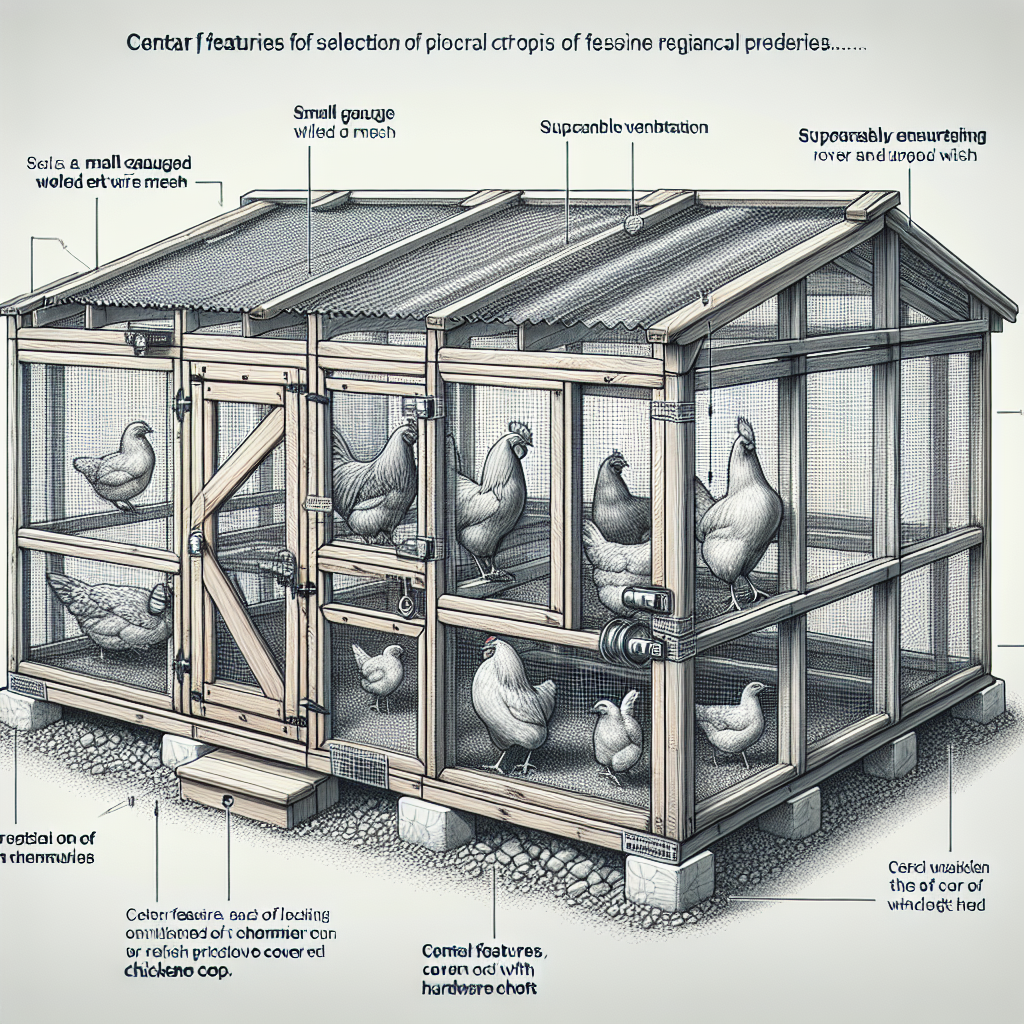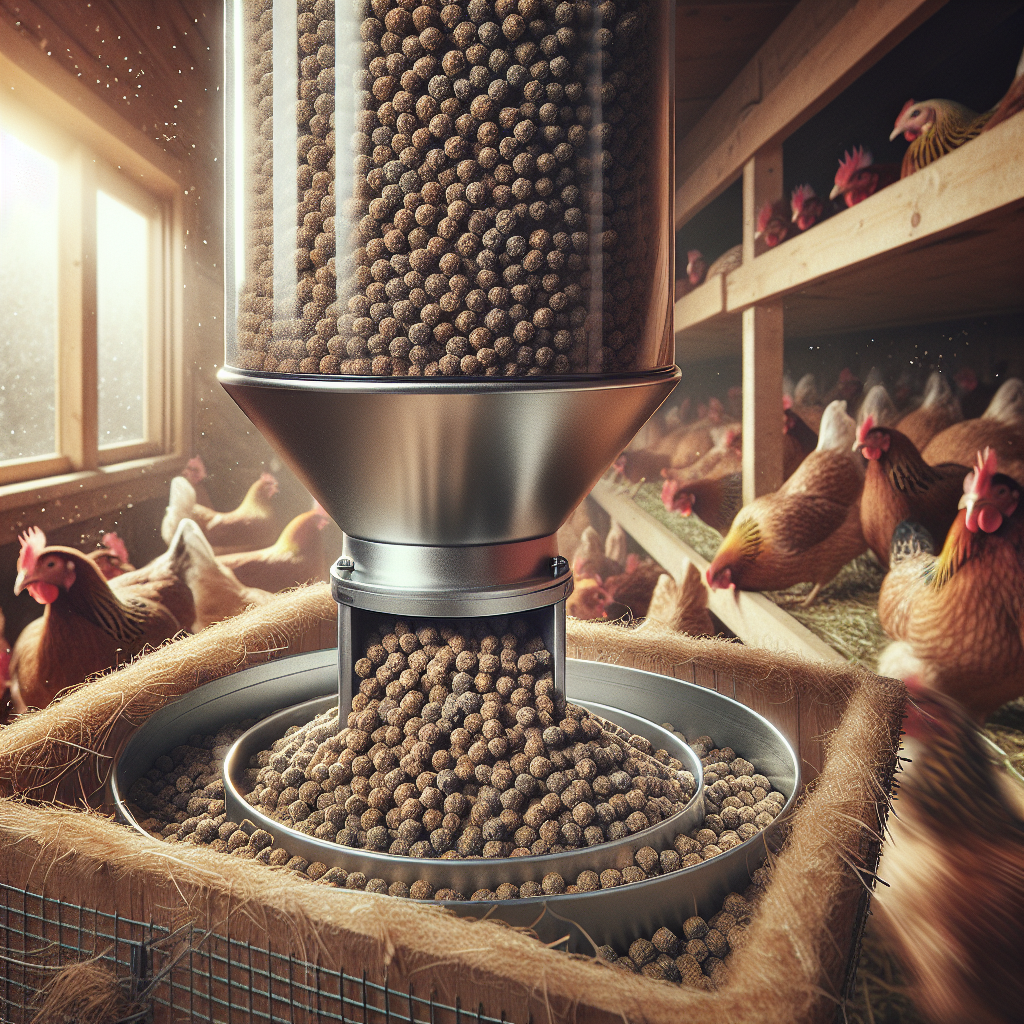Are you a backyard chicken enthusiast looking for ways to protect your feathered flock from the threats of local predators? If so, you’ve come to the right place. This article explores practical tips and techniques on designing a coop that is specifically tailored to safeguard against regional predators. From foxes to raccoons and everything in between, we’ve got you covered. So put on your creative hat and get ready to build a secure haven for your cherished chickens.
Determining the Predators
When designing a coop, it’s crucial to start by researching the specific regional predators in your area. Different regions may have different types of predators, so it’s essential to identify which ones pose a threat to your chickens. By understanding the predators in your vicinity, you can tailor your coop design to effectively protect your flock.
Researching Regional Predators
Begin by conducting research or consulting with local agricultural authorities to determine the common predators in your region. This research will give you valuable insights into the behaviors, habits, and patterns of these predators. By familiarizing yourself with their characteristics and tendencies, you’ll be able to develop strategies to counter their threats effectively.
Identifying Predators in Your Area
After conducting your research, it’s crucial to identify the specific predators that are commonly found in your area. This can be done by observing any signs of predator activity, such as footprints, droppings, or even attacks on neighboring flocks. Identifying the predators in your vicinity will enable you to understand the specific threats you need to address in your coop design.
Evaluating Predator Behavior
Once you have identified the predators in your area, it’s important to evaluate their behavior and hunting patterns. Some predators may be more opportunistic and likely to strike during certain times of the day, while others may be nocturnal. Understanding their behavior will help you implement appropriate preventive measures to safeguard your flock.
Understanding Coop Design Principles
To build a secure coop, it’s essential to understand the core principles of coop design. By considering factors such as suitable materials, proper ventilation, a secure foundation, perching areas, nesting boxes, and easy access for cleaning and maintenance, you can create a coop that effectively protects your chickens.
Determining Suitable Materials
Selecting the right materials for your coop is crucial. Opt for sturdy and durable materials that can withstand predator attacks and harsh weather conditions. Welded wire mesh or hardware cloth with smaller gauge openings can be advantageous in keeping predators out while still allowing adequate airflow and light into the coop.
Importance of Proper Ventilation
Proper ventilation is vital for maintaining a healthy and comfortable environment inside the coop. Adequate airflow helps reduce humidity, ammonia buildup, and the risk of respiratory illnesses. At the same time, it’s crucial to ensure that the ventilation openings are small enough to prevent predator entry. Installing hardware cloth over vents and windows can prevent unwanted visitors from entering.
Creating a Secure Foundation
Building a coop on a secure foundation is essential for protecting against digging predators. Ensure that the coop is elevated off the ground and supported by sturdy piers or concrete blocks. This makes it more difficult for predators to gain access to the coop from below.
Addressing Perching Areas
Predators often target chickens when they are roosting on perches. Incorporate predator-proof design features such as sloping or slippery surfaces on perching areas to deter predators from reaching your flock. Additionally, ensure there is enough space between perches to prevent overcrowding, which can lead to increased vulnerability.
Considerations for Nesting Boxes
When designing nesting boxes, prioritize safety and security. Use materials like plywood or solid wood to create sturdy boxes that can withstand predator attempts to access them. Position the nesting boxes away from windows or other potential entry points, and ensure they are easily accessible for egg collection but not easily accessible for predators.
Ensuring Easy Access for Cleaning and Maintenance
Make sure your coop design allows for easy access for cleaning, maintenance, and inspections. This will help you stay on top of any vulnerabilities or signs of predator activity. Incorporate large doors or removable panels that allow you to reach all areas of the coop to clean and inspect thoroughly.
Building a Secure Structure
Building a secure structure involves carefully considering various factors such as optimal coop location, the right coop size, applying strong reinforcements, predator-proof fencing, securing doors and windows, and implementing rodent control measures.
Optimal Coop Location
Choosing the right location for your coop is crucial for its security. Select an area that provides good visibility and is not easily accessible to predators. Avoid placing the coop near dense vegetation, as this can provide cover for predators. Additionally, ensure the coop is not in a low-lying area prone to flooding, as this can compromise its security.
Choosing the Right Coop Size
The size of your coop should be appropriate for the number of chickens you have. Overcrowding can lead to stress, which can make chickens more vulnerable to predators. Provide at least 3-4 square feet of space per chicken inside the coop and ample space in the outdoor run as well.
Applying Strong Reinforcements
Strong reinforcements are crucial for protecting against predators’ attempts to breach the coop’s structure. Reinforce corners, joints, and edges with additional bracing or metal plates to prevent predators from prying their way in. Use sturdy hardware and screws that are not easily tampered with.
Installing Predator-Proof Fencing
Proper fencing is essential in keeping predators out of your coop and run area. Use hardware cloth with a small mesh size (½ inch) to prevent predators from squeezing through or reaching through the fencing. Bury the fencing at least 12 inches into the ground to deter digging predators.
Securing Doors and Windows
Make sure all doors and windows are secured with latches that cannot be easily manipulated by predators. Reinforce them with additional locks or bolts if necessary. Avoid using materials like chicken wire, which can be easily chewed through or broken by determined predators.
Implementing Rodent Control Measures
Rodents can attract larger predators like raccoons and snakes, so it’s crucial to implement measures to control their population. Keep food securely stored in rodent-proof containers, seal any gaps or cracks where rodents can enter, and consider using traps or bait stations to minimize their presence.
Protection Against Ground Predators
Ground predators can pose a significant threat to your chickens. Implementing measures such as using buried hardware cloth, creating an apron or skirt around the coop, and designing a predator-proof run can help protect your flock.
Using Buried Hardware Cloth
Burying hardware cloth around the perimeter of the coop and run area can deter digging predators from gaining access. Bury the hardware cloth at least 12-18 inches into the ground, making it difficult for predators to dig underneath.
Creating an Apron or Skirt Around the Coop
An apron or skirt around the coop involves extending hardware cloth horizontally, outward from the base of the coop. This prevents predators from burrowing beneath the coop by creating a barrier that extends a few feet out. Secure the edge of the hardware cloth with rocks, bricks, or other heavy objects to keep it in place.
Designing a Predator-Proof Run
If you allow your chickens to free-range during the day, it’s essential to provide a secure run area. The run should be fully enclosed with predator-proof fencing, utilizing the same principles mentioned earlier. Consider covering the top of the run with hardware cloth to prevent aerial attacks.
Defense Against Avian Predators
Avian predators, such as hawks and owls, can pose a threat to your flock. Taking measures like covering windows with hardware cloth, adding protective roving or netting, implementing motion-activated devices, and utilizing noise deterrents can help deter avian predators.
Covering Windows with Hardware Cloth
To prevent birds of prey from gaining access through windows, secure hardware cloth over any openings. Make sure the mesh size is small enough to prohibit entry while still allowing for proper airflow and ventilation.
Adding Protective Roving or Netting
Adding protective roving or netting above the coop and run area can create an extra layer of defense against avian predators. Use a sturdy netting material that cannot be easily penetrated or torn by birds.
Implementing Motion-Activated Devices
Motion-activated devices, such as sprinklers or noise-making devices, can startle and deter avian predators. Place these devices strategically around the coop and run area to discourage birds from approaching.
Utilizing Noise Deterrents
Certain noise deterrents, such as wind chimes or predator calls, can create an environment that birds find uncomfortable or threatening. Install these noise deterrents near the coop and run area to discourage avian predators from targeting your flock.
Precautions Against Nocturnal Predators
Nocturnal predators, like raccoons and foxes, are particularly active during the night. Protecting against them involves installing proper lighting, utilizing motion-sensor lighting, considering the use of guard animals, and implementing alarm systems.
Installing Proper Lighting
Installing adequate lighting around the coop and run area can help deter nocturnal predators. Illuminate areas where predators may attempt to access the coop, such as entrances and vulnerable spots. Use bright, motion-activated lights for maximum effectiveness.
Utilizing Motion-Sensor Lighting
Motion-sensor lighting can startle and discourage nocturnal predators. These lights will activate when motion is detected, potentially alerting you to the presence of a predator and discouraging their approach.
Consideration for Guard Animals
Guard animals, like dogs or geese, can serve as effective deterrents against nocturnal predators. By instinct, these animals will protect your flock and alert you to potential threats. Research suitable guard animals for your specific region and consider their compatibility with chickens.
Implementing Alarm Systems
Installing an alarm system around your coop can provide an additional layer of security. Dependent on your specific requirements, options can include motion detectors, sound alarms, or even connected technologies that notify you of potential predator activity.
Protection from Climbing Predators
Climbing predators, such as raccoons and weasels, can pose a unique threat to your coop. Implementing measures like installing slick surfaces, incorporating barriers or shields, and creating sloping structures can help thwart climbing predators’ attempts.
Installing Slick Surfaces
Climbing predators can be deterred by installing slick surfaces on potential entry points like walls or fences. Apply materials like metal or plastic sheeting, which are difficult for them to grip or climb.
Incorporating Barriers or Shields
Install barriers or shields around potential entry points, such as doors or windows, to prevent climbing predators from gaining access. Reinforce these areas with sturdy materials that cannot be easily manipulated or breached.
Creating Sloping Structures
Predators that rely on climbing may be discouraged by creating sloping structures without any footholds. Ensure that your coop design incorporates sloping surfaces or angled sections that make it difficult for predators to gain a foothold and access the coop.
Securing Coop from Digging Predators
Digging predators, like raccoons or foxes, can pose a particular challenge when it comes to coop security. Protecting against them involves burying hardware cloth around the coop, using underground barriers, and applying additional digging deterrents.
Burying Hardware Cloth Around the Coop
Create a barrier against digging predators by burying hardware cloth around the perimeter of your coop. Bury the cloth at least 12-18 inches deep and extend it outward to prevent predators from digging underneath.
Using Underground Barriers
Use underground barriers, such as paving stones or concrete, around the perimeter of the coop to deter digging predators. These barriers make it difficult for predators to excavate close to the coop.
Applying Digging Deterrents
In addition to using underground barriers, consider applying deterrents to discourage digging predators. Natural deterrents like gravel or large rocks can make digging uncomfortable for predators and may discourage their attempts to breach the coop.
Implementing Predators’ Natural Enemies
Encouraging the presence of natural predators in your area can play a role in reducing the population of potential threats. Creating wildlife-friendly habitats near the coop, considering the use of guardian animals, and understanding the delicate balance of ecosystems can promote a natural deterrent against predators.
Encouraging Natural Predators in the Area
By creating a wildlife-friendly environment around your coop, you can attract natural predators that feed on potential threats to your flock. Encourage the presence of birds of prey, snakes, or other natural predators by providing suitable habitats with food sources like native plants, water sources, and sheltered areas.
Creating Wildlife-Friendly Habitats Near Coop
Designating areas near your coop specifically for wildlife-friendly habitats can be advantageous. Incorporate native plants, birdhouses, or nesting boxes to attract and support natural predators. This can create a balanced ecosystem where potential threats are naturally controlled.
Considering the Use of Guardian Animals
Guardian animals, like dogs or llamas, can serve as effective deterrents against predators. Through their presence and natural territorial instincts, they can help keep potential threats away. Research suitable guardian animals for your specific location, taking into account compatibility with chickens and proper training.
Constant Monitoring and Maintenance
Ensuring the ongoing security of your coop requires constant monitoring and maintenance. Regularly inspect and maintain the coop, observe predator activity patterns, update and reinforce the coop as needed, and monitor the surrounding environment for any changes that may attract or enable predators.
Regular Inspection and Maintenance
Frequently inspect the coop and surrounding areas for signs of wear, damage, or vulnerabilities. Look for any potential entry points, weak spots, or signs of predator activity. Regular maintenance, such as repairing any damaged areas, reinforcing locks, or replacing worn-out materials, is essential for a secure coop.
Observing Predator Activity Patterns
Develop a routine of observing predator activity patterns in your area. Pay attention to the specific times of day or night when potential threats are more active. This awareness will help you implement additional preventive measures during vulnerable periods.
Updating and Reinforcing Coop as Needed
As predators adapt, it’s important to continually update and reinforce your coop’s security. Stay informed about new strategies or techniques predators may employ. Regularly check for any weaknesses or areas that may need further reinforcement to prevent potential breaches.
Monitoring Surrounding Environment
Be aware of any changes in the surrounding environment that might attract or enable predators. For example, if there is a sudden increase in rodent populations or a nearby construction site, take proactive measures to minimize their impact on your coop’s security.
By following these guidelines and tailoring them to your specific regional predator threats, you can design a coop that provides a safe and secure environment for your chickens. Remember that constant vigilance, maintenance, and adaptation are key to ensuring the ongoing protection of your flock.




